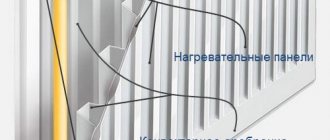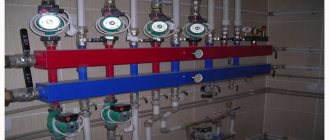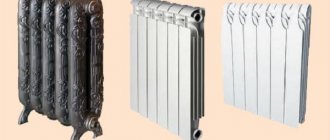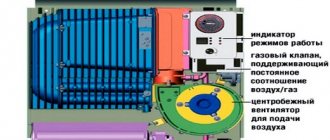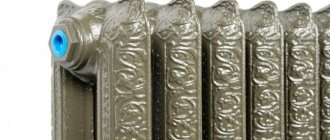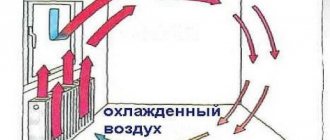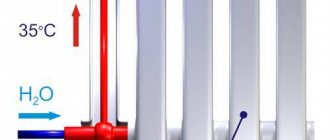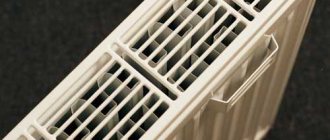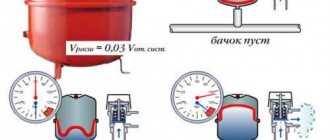The best radiator manufacturers
It is worth noting! The most reliable brands that manufacture aluminum radiators are:
- Rifar. A domestic manufacturer that produces high-quality equipment using Italian innovative technology. A special feature of the radiators is a long warranty period of 10 years.
- Global. An Italian brand that produces radiators with reference quality. The equipment can be used both in apartments and private houses. The products are characterized by high working pressure.
- Royal. This brand produces budget models of aluminum radiators. They can withstand high pressure thanks to a special casting technique. The original design makes the batteries very popular among consumers.
- ROMMER. The equipment is produced using European technologies, is of high quality, and can cope with heavy loads. Affordable price complements all the advantages.
Aluminum battery device
When considering the design of an aluminum heating radiator, it should be noted that the design of the battery can be solid or sectional.
A sectional aluminum heater consists of 3-4 separate sections. As a rule, titanium, silicon, and zinc are added to aluminum. These metals make the product stronger and more resistant to tearing and corrosion. All sections are connected to each other using a threaded connecting element. Silicone gaskets are used to seal the connection. The radiators have a polymer coating inside to prevent the possibility of battery rupture.
Solid aluminum radiators consist of profiles. Profiles are made by extrusion.
No additional metals are added to aluminum radiators.
What gives plasticity to the material. The profiles are connected to each other by welding. This connection is highly durable and reliable. Like sectional ones, one-piece radiator models are coated inside with a polymer layer.
Depending on the production method, there are radiators made by casting, extrusion and anodized products (made from aluminum of a higher purity).
Technical characteristics of aluminum heating radiators
Due to its high technical characteristics, many people decide to buy an aluminum radiator for heating their apartment. The main technical parameters include:
- operating pressure. It ranges from 10 to 15 atmospheres. In residential apartments, operating pressure can exceed the norm by 3-4 times. In this regard, such radiators are rarely installed in city houses. But for private homes, such a heater will be an ideal solution;
- crimping pressure. Located in the range from 20 to 50 atmospheres;
- heat transfer coefficient. For the standard section it is 82-212 W;
- the maximum coolant temperature can reach +120 degrees;
- one section can weigh from 1 to 1.5 kg;
- capacity of each section is from 0.25 to 0.46 l;
- the distance between the axes can be 20, 35, 50 cm. There are models in which this parameter can reach 80 cm.
The manufacturer indicates the parameters for each radiator model in the device passport. Considering the technical characteristics of aluminum heating radiators, the price for them is quite justified and depends on the type of battery, the number of sections and the manufacturer.
Advantages and disadvantages of aluminum radiators
Before you buy aluminum heating radiators, you need to consider what advantages and disadvantages this device has.
The main advantage of an aluminum battery is its compactness and much lighter weight than cast iron systems. You can read more about cast iron heating radiators here. The equipment warms up very quickly and transfers heat well to the room. The service life is quite long. Another advantage is the division into sections - it is possible to select the desired length of the battery. It should be noted that for aluminum radiators the price is indicated per section. This makes it easy to calculate the approximate cost of a sectional device.
Since the equipment is small and weighs little, it is easy to install. Installation can even be carried out on a plasterboard wall. Modern models look aesthetically pleasing and stylish. Aluminum is easy to process. This gives manufacturers the opportunity to experiment with battery design. You can choose an option for any interior. Aluminum radiators are most suitable for autonomous heating systems. Despite the high technical characteristics and a lot of advantages, the price of aluminum heating batteries is quite affordable.
The disadvantages of aluminum radiators include low resistance to corrosion. And this can greatly affect the overall condition of the battery. Aluminum is a fairly active metal by nature. If the oxide film covering the surface is damaged, the protective layer will be destroyed due to the release of hydrogen. To increase anti-corrosion properties, a polymer coating is used. If the battery does not have a polymer coating, then you cannot turn off the taps on the supply pipes. Otherwise, the battery may rupture under pressure.
What characteristics should you pay attention to when choosing aluminum radiators?
Important! Radiators differ from each other not only in their exterior. There are a number of parameters that need to be taken into account when purchasing:
- Type. The devices are anodized - they can withstand high pressure, are resistant to corrosion, and have great heat transfer; extruded - produced using the technique of extruding individual parts, connected into a finished product by welding or gluing; cast - made by injection molding, using an alloy of aluminum and silicon. The latter are considered the most popular option.
- Acid-base balance range. This indicator is especially important when purchasing a radiator for an apartment, since in a private house the owner can independently control the quality of the water.
- Height . It is selected in accordance with the installation location and the location of the connection pipes.
- Thermal power. Determined according to the area that needs to be heated. Manufacturers usually indicate the power of one section.
What are the types of aluminum radiators?
Aluminum is highly reactive and occurs in nature in the form of compounds.
Aluminum products, including heating radiators, are alloys.
Aluminum-silicon alloys (silumins) have good ductility and casting properties.
According to the production method, aluminum batteries are divided into:
- Cast.
- Extrusion.
- Combined.
Casting method. Each section is cast in a separate mold under high pressure. In the future, the sections will be assembled on nipples. The silumin content in such radiators is about 12%. More metal comes out than with the second method. To reduce the cost, recyclable materials are used.
Extrusion method. The molten metal is “squeezed out” through the forming holes and then joined (joining methods: nipples, adhesives and boring, manufacturers try to keep secret). The battery sections are fastened together and can no longer be added or decreased. Although the extruded metal itself is more expensive, the cost of such a radiator is lower due to the economical consumption of materials. The composition includes alloying additives, and no recycled materials are used.
Combined method. Some parts of the radiator are cast (horizontal collectors), while others are made by extrusion (vertical channels). This achieves the best value for money.
The times when all radiators were the same are long gone. Nowadays the market offers a variety of design solutions and all kinds of materials. Bimetallic batteries: which ones are better? Comparative characteristics of radiators and features of choice.
Read about how to calculate the number of heating radiator sections here.
And here https://microklimat.pro/otopitelnoe-oborudovanie/otopitelnye-pribory/termoregulyator-dlya-radiatora-otopleniya.html you will learn why a thermostat for a heating radiator is needed, what types of devices exist and how to install the device.
Rating of the TOP 10 best aluminum radiators
Let's consider the best models depending on certain parameters.
The best models in terms of price/quality ratio
Let's consider which radiators are distinguished by a harmonious balance between cost and quality.
Royal Thermo Revolution 500 x4
High-quality equipment with 4 sections from a domestic manufacturer.
High heat transfer is ensured thanks to the special wave-like shape of each section.
The advantage of this model is the 10-year warranty period.
The device is also characterized by maximum coating durability, which is ensured by 7-level coloring.
Specifications:
- design - wall-mounted;
- connection type - side;
- maximum operating temperature - 110 degrees;
- pressure - 20 bar;
- height - 57 cm;
- width - 32 cm;
- thickness - 8 cm.
Advantages
- increased strength of the plug;
- Beautiful design;
- a light weight;
- relatively high heat transfer;
- resistance to mechanical damage;
- good paint quality.
Flaws
- the back surface is poorly painted;
- on some models the joints between sections are visible;
- Despite the reasonable price, it is slightly higher than similar models.
Royal Thermo Indigo 500 x4
Another Russian-made model, which is manufactured using Italian technology.
This option is great for apartments, individual buildings, and industrial premises.
High quality coating is ensured by two-level painting.
The devices are available in white and have a pleasant appearance.
Specifications:
- design - wall-mounted;
- connection type - side;
- maximum operating temperature - 110 degrees;
- pressure - 20 bar;
- height - 58.5 cm;
- width - 32 cm;
- thickness - 10 cm.
Advantages
- good heat dissipation;
- convenient arrangement of sections;
- easy to maintain;
- stylish exterior;
- availability of protection against water hammer;
- there is reverse convection.
Flaws
- not suitable for rooms where water has a high Ph level;
- build quality is not always high;
- Sometimes there are problems with replacement under warranty.
Royal Thermo DreamLiner 500 x4
A universal option, suitable for both central and autonomous heating.
Radiators will perfectly complement the design of apartments and country cottages. They are distinguished by high quality painting.
Uniformity and durability are ensured by multi-level application of paints from a Dutch and German manufacturer.
A nice bonus is the 10-year warranty period.
Specifications:
- design - wall-mounted;
- connection type - side;
- maximum operating temperature - 110 degrees;
- pressure - 20 bar;
- height - 58 cm;
- width - 32 cm;
- thickness - 8 cm.
Advantages
- beautiful shape;
- high quality materials;
- reliability;
- multi-level homogeneous coating;
- acceptable price;
- maximum protection against leaks;
- easy installation.
Flaws
- immediately after connection it makes strange sounds;
- power is slightly lower than that of similar models;
- The back side is not as high quality as the front.
The best models with side connection
Stay up to date! Lateral connection in radiators makes it possible to make it one-sided or two-sided.
This option is especially relevant for standard apartments when replacing old batteries . Let's look at the best models of this type.
Global VOX R 500
Radiators are manufactured in Italy using injection molding.
This model is installed in rooms with a closed or central heating system.
Reliable coverage is ensured by dipping an epoxy primer, after which a special decorative paint is sprayed onto the surface.
Radiators of this model are available in white.
Specifications:
- design - wall-mounted;
- connection type - side;
- maximum operating temperature - 110 degrees;
- pressure - 16 bar;
- height - 59 cm;
- width of one section - 8 cm;
- thickness - 9.5 cm.
Advantages
- the presence of solid ribs on the sides;
- quickly warms up the room;
- nice design;
- reliability;
- long warranty period.
Flaws
- high price;
- when installing in rooms with high humidity, the structure should be protected from mechanical damage, otherwise the paint will begin to peel off;
- installation difficulties.
Global ISEO 500
This model allows you to heat large rooms.
The radiator can be installed in buildings with any type of heating.
The beautiful design will complement the laconic interior of the room.
The reliability of the surface is ensured by initial immersion, then application of special paint, which includes polyester.
Specifications:
- design - wall-mounted;
- connection type - side;
- maximum operating temperature - 110 degrees;
- pressure - 16 bar;
- height - 58.2 cm;
- width of one section - 9 cm;
- thickness - 8 cm.
Advantages
- Beautiful design;
- high quality coating;
- good heat dissipation;
- long service life;
- reliability.
Flaws
- high price;
- relatively heavy weight;
- no thermostat.
ROMMER Al Plus 200
A model with a small height that will provide warmth and compactness in a small room.
Connection is not difficult, although it is better to entrust this matter to a professional.
The laconic design of this radiator will be a great addition to a room with a small or medium sized area.
Specifications:
- design - wall-mounted;
- connection type - side;
- maximum operating temperature - 110 degrees;
- pressure - 14 bar;
- height - 27.6 cm;
- width of one section - 8 cm;
- thickness - 9.6 cm.
Advantages
- laconic design;
- good power;
- inexpensive cost;
- compactness;
- high leakage protection.
Flaws
- flimsy design - the radiator bends if transported poorly;
- not always high-quality assembly;
- not suitable for large rooms.
ROMMER Al Optima 500
A budget option that is not inferior in quality to more expensive models.
These devices are sold section by section, which is very convenient when calculating the heated area.
Suitable for both office buildings and apartments. Installation does not take much time or hassle.
Specifications:
- design - wall-mounted;
- connection type - side;
- maximum operating temperature - 110 degrees;
- pressure - 12 bar;
- height - 56.8 cm;
- width of one section - 7.7 cm;
- thickness - 7.8 cm.
Advantages
- acceptable price;
- a light weight;
- reliable design;
- stylish design;
- easy to maintain.
Flaws
- over time the surface turns yellow;
- not suitable for rooms where water has a high Ph;
- Careful transportation is required.
Royal Thermo Revolution 350
A medium-sized device with high build quality.
The wave-shaped fin design ensures maximum heat transfer.
Assembly using Italian technology provides the maximum level of safety against leaks and extends service life.
Specifications:
- design - wall-mounted;
- connection type - side;
- maximum operating temperature - 110 degrees;
- pressure - 20 bar;
- height - 42 cm;
- width of one section - 8 cm;
- thickness - 8 cm.
Advantages
- original exterior;
- durable and reliable design;
- high heat transfer rate;
- compactness;
- does not require additional maintenance other than regular wiping.
Flaws
- poor equipment;
- high price;
- The back surface is not painted as well as the front.
The best models with bottom connection
Radiators with bottom connections are usually installed in government agencies, entertainment centers, and private homes.
Keep in mind! The pipes in this case pass to the battery perpendicularly from below.
Let's look at the best models with a bottom connection.
Rifar Alum Ventil 350 x6
A medium-sized device that efficiently heats small rooms.
This model is compact and discreet in design.
Therefore, it will be an original addition to a room with any interior.
A special feature is the presence of a valve that can be connected directly without using an adapter.
Specifications:
- design - wall-mounted;
- connection type - bottom;
- maximum operating temperature - 135 degrees;
- pressure - 20 bar;
- height - 41.5 cm;
- width of one section - 8 cm;
- thickness - 9 cm.
Advantages
- compact size;
- high heat transfer rate;
- laconic exterior;
- convenient connection;
- high quality coating.
Flaws
- high price;
- not always high-quality assembly;
- subject to mechanical damage.
KZTO Elegant-mini 1 130x80
Model with universal tubular type design.
This radiator has aluminum-copper equipment, which ensures a long service life.
It has good heat transfer, making it possible to heat large rooms.
Specifications:
- design - universal;
- connection type - bottom;
- maximum operating temperature - 130 degrees;
- pressure - 15 bar;
- height - 8 cm;
- width - 50 cm;
- thickness - 13 cm.
Advantages
- high level of heat transfer;
- high-quality assembly;
- hassle-free installation;
- long service life;
- high-quality manufacturing materials.
Flaws
- high price;
- not very attractive design;
- bulky design.
Device Features
The models offered by modern manufacturers are distinguished by great reliability and high performance. They become most effective when they match the technical parameters of the heating system with which they work. Some models are suitable for heating large rooms, others for smaller spaces.
The design of a heating radiator covers such parameters as design design, material of manufacture, performance characteristics, and determines the following factors:
- Operational capabilities of the model.
- The type and quality of coolant that will be used in the system.
- Operating pressure.
- Connection option.
- Various installation nuances.
The operating principle of heating radiators is incredibly simple. The heat-carrying medium (water, oil, steam), which has the required temperature, continuously moves through the pipeline. As a result, it ends up in a heating device, due to which the air temperature in the room increases.
When choosing a battery, imported or domestic, you need to remember the operating conditions in existing heating networks. The centralized heating system is characterized by fluctuations in temperature and pressure, and poor quality of the coolant.
Depending on the method of heat transfer, the units are classified as follows:
- Convectors. Heat from the heating element is transferred to the room due to the exchange of air flows with different temperatures. This process is called convection. During this process, the air, which has become warm after contact with the heating element, tends upward and gives way to cold currents. Gas and electric convectors are used for heating.
- Radiators. Heat is radiated from the heated surface, the temperature of which increases due to the movement of the coolant through the pipes. This is the operating principle of the equipment traditionally used in our homes.
Manufacturers also offer combined type heating units. In such convector-radiators, most of the heat is generated by energy radiation, and the rest is generated by convection. Thanks to this, the quality of room heating is significantly improved.
Classification by material
To understand how a heating battery works and decide on the choice of model, you need to study the various options for such devices. For example, the material of manufacture affects the performance, functionality and durability of the entire system.
Manufacturers offer radiators made of the following metals:
Cast iron
Such radiators are reliable in operation and resistant to corrosion, and have low thermal conductivity. Despite their heavy weight, they are still in demand due to their low price. In the system they usually have a one-way connection. Although this scheme is the simplest, it requires a large volume of coolant to maintain a constant temperature and significant circulation.
Steel
Such batteries are most often used by owners of private houses. They are distinguished by their aesthetic appeal, dissipate heat well, weigh little, and are easy to install yourself. Among the disadvantages are they are afraid of water hammer and react poorly to oxygen in pipes.
Aluminum and bimetal
These are lightweight and reliable devices, but corrosion is their bane. For private and apartment buildings, different options are offered depending on the pressure the device can withstand.
Equipment made of steel and aluminum (bimetal) can be connected in different ways. Its characteristics are better than those of cast iron counterparts. Bimetallic batteries can pass much less hot water through them, while their contact area with air is larger.
Varieties by shape
Equipment options can be divided into sectional, tubular, panel and plate. All of them are successfully used in residential construction. Some are optimal only for private houses, others – exclusively for multi-storey houses.
Sectional
They are formed by separate ribs connected to each other by nipples. Most often they are made of cast iron, aluminum and composite materials. They are most popular because they allow you to regulate the power yourself. To do this, it is enough to increase or reduce the number of sections.
Studying the structure of a cast-iron heating battery in cross-section, you can see the collectors at the top and bottom that form horizontal channels. They serve to move coolant. Debris and large impurities settle in the lower channel, which helps to avoid clogging of the entire unit.
The main disadvantage of sectional devices is the possibility of leaks at the points where the sections are connected. To avoid this problem, it is recommended to carry out installation taking into account the properties of the materials from which they are made.
Tubular
In them, the coolant moves through tubes. The main design details are the collectors located at the top and bottom. Vertical elements are used to connect them together. The thermal conductivity of such a sealed structure depends on the size, number, diameter and material of the tubes. On sale you can find models not only with a round, but also with an oval or rectangular cross-section. The dimensions of the equipment also vary significantly. This allows you to successfully fit it into the interior.
